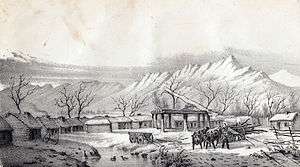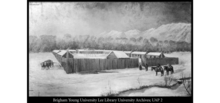Fort Utah
Fort Utah (also known as Fort Provo)[1] was the original settlement at Provo, Utah, United States and was established March 12, 1849. The original settlers were President John S. Higbee, and about 30 families or 150 persons that were sent from Salt Lake City to Provo by President Brigham Young. Several log houses were erected, surrounded by a 14-foot (4.3 m) palisade 20 by 40 rods in size (330 by 660 feet [100 by 200 m]), with gates in the east and west ends, and a middle deck, for a cannon. The fort was first located west of town, but was moved to Sowiette Park in April, 1850.[2][3]

Battle at Fort Utah

In late 1849, tensions between Ute Indians and members of the Church of Jesus Christ of Latter-day Saints in Utah Valley escalated after a Church member killed a Ute known as Old Bishop, whom he accused of stealing his shirt.[4] The Mormon and two associates then hid the victim's body in the Provo River. Details of the murder were likely withheld, at least initially, from Brigham Young and other Church leaders. Settlers at Fort Utah did, however, report other difficulties with the Indians, including the firing of weapons at settlers and the theft of livestock and crops. Brigham Young counseled patience, telling them to "stockade your fort, to attend to your own affairs and let the Indians take care of theirs."[5] Tensions mounted at Fort Utah after the Utes demanded that the settlers turn over the murderers[6] because the settlers refused to turn over those involved in the murder of Old Bishop to the Utes or to pay reparations for his death. In the winter of 1849–1850, a measles epidemic spread from the Mormon settlers to the Ute camps, killing many Indians and heightening tensions. At a council of ecclesiastical leaders in Salt Lake City on January 31, 1850, the leader of Fort Utah reported that the Utes’ actions and intentions were growing increasingly aggressive: "they say they mean to hunt our Cattle. & go & get the other Indians to kill us."[7] In response, Brigham Young authorized a campaign against the Utes [8] telling them to kill all the men and take the women and children captive. On February 8, 1850, a militia from Salt Lake surrounded a group of around seventy people at Big Elk. After two days of fighting, the Utes surrendered. The army killed the men and sent the women and children up to Salt Lake as prisoners. A series of battles in February 1850 resulted in the deaths of dozens of Utes and one Mormon.[9] These events contributed to the Walker War.[10]
Monuments and replica
On August 30, 1937, a monument to commemorate the fort was dedicated at what was believed to be the original site of the 1849 structure.[11] The monument was erected by the Daughters of the Utah Pioneers with assistance from the Sons of the Utah Pioneers. Constructed with a concrete base and a center section of native stone, the monument was topped with cement molded into a fluted shape meant to reflect the fort's architecture. Also included in the monument's construction was a metal plaque with a history of the fort.[12]
Decades later, Provo City purchased the property surrounding the monument and with the help of the Utah Lake Lions Club began to develop a public park on the land, known as "Fort Utah Park."[13][14] A miniature replica of the 1849 fort was included as part of the park's initial construction. The replica included log construction, embrasures, a cannon situated on a raised center platform, and two block houses in opposite corners of the structure.[15] The replica was completed in August 1972, in time to host that year's annual encampment of the Sons of the Utah Pioneers. Citing safety issues and lack of historical accuracy in the replica, the structure was demolished by Provo City in early 2017.[16]
In the late 1990s, a committee tasked with researching the original 1849 structure in preparation for Provo's sesquicentennial celebration determined that the location of the 1937 monument and 1972 fort replica was not at the fort's original site. Rather it was determined that the site of the fort was close where Interstate 15 crosses the Provo River, and that the freeway or a nearby mobile home park, was likely built directly over the location.[17] Subsequently in 1999 the Provo Sesquicentennial Committee dedicated a new monument just east of Interstate 15 along the Provo River Parkway Trail. This new monument is meant to commemorate Fort Utah at a location closer to the site of the 1849 structure.
The site of the 1850 fort is located at Provo's North Park, formerly known as Sowiette Park.[18]
References
- "Chapter Twenty-Seven: Establishing a Refuge in Deseret". churchofjesuschrist.org. Salt Lake City: The Church of Jesus Christ of Latter-day Saints. 2003. Retrieved 30 Mar 2016.
Fort Utah was also called Fort Provo in honor of Etienne Provot, an early French trapper.
- "Fort Utah". provolibrary.com. Provo City Library. Retrieved 30 Mar 2016.
- Weiser, Kathy (Aug 2011). "Utah Forts of the Old West – Page 2". legendsofamerica.com. Archived from the original on 29 March 2016. Retrieved 30 Mar 2016.
- Peace and Violence among 19th-Century Latter-day Saints
- Brigham Young letter to Isaac Higbee, Oct. 18, 1849, Brigham Young Office Files, Church History Library, Salt Lake City.
- Peace and Violence among 19th-Century Latter-day Saints
- Historian’s Office General Church Minutes, Jan. 31, 1850, Church History Library, Salt Lake City.
- An account of the dialogue of the January 31 meeting can be found in BYC, Microfilm reel 80, box 47, folder 6. Brigham Young is quoted as stating: "I say go [and] kill them. . . . Tell Dimick Huntington to go and kill them—also Barney Ward—let the women and children live if they behave themselves. . . . We have no peace until the men [are] killed off—never treat the Indian as your equal." Wells's Special Order No. 2 can be found in the Utah State Archives, State Capitol, Salt Lake City, Utah Territorial Militia Correspondence, 1849–1863, ST-27, Microfilm reel 1, Document No. 5
- D. Robert Carter, Founding Fort Utah: Provo’s Native Inhabitants, Early Explorers, and First Year of Settlement (Provo, Utah: Provo City Corporation, 2003), 52, 114–15, 135, 142, 145, 153–57, 163, 227. Contemporaneous sources indicate that the number of Indians who died was between 24 and 40, though a much later reminiscence places the death count among the Utes at around 100. (See Epsy Jane Williams, Autobiography, [1], Church History Library, Salt Lake City; and Jared Farmer, On Zion's Mount: Mormons, Indians, and the American Landscape [Cambridge, Massachusetts, and London: Harvard University Press, 2008], 67–77.)
- Utah Historical Quarterly Volume XLVI 0pen Hand and Mailed Fist: Mormon-Indian Relations in Utah, 1847–52 by Howard A. Christy
- Seidl, George W (August 31, 1937). "Daughters of Pioneers Dedicate Monument at Site of Old Fort Utah". The Evening Herald. Provo, Utah. Retrieved July 3, 2018.
- "Fort Utah Monument to Be Dedicated Monday". The Sunday Herald. Provo, Utah. August 29, 1937. Retrieved July 3, 2018.
- "Utah Lake Lions Plan Development of Historic Fort Utah Site As Park". The Sunday Herald. Provo, Utah. October 8, 1967. p. 3.
- "Fort Utah Park in Provo Taking Shape; Utah Lake Lions Club Plants Trees". The Daily Herald. Provo, Utah. April 24, 1970. p. 10.
- "Fort Utah Replica Nears Finish". The Sunday Herald. Provo, Utah. July 23, 1972. p. 3.
- "Non-Historic Fort Structure Demolition". John Curtis: Provo Insider. Provo Utah Mayor's Office. January 25, 2017. Retrieved July 7, 2018.
- Romboy, Dennis (July 27, 1998). "Is replica at site of original fort?". The Deseret News. Salt Lake City. Retrieved July 3, 2018.
- Carter, D. Robert (July 22, 2009). "Despite hardship, Provo historians pushed for pioneer village". The Daily Herald. Provo, Utah. Retrieved July 7, 2018.
Further reading
- Carter, D. Robert (2003), Founding Fort Utah: Provo's Native Inhabitants, Early Explorers, and First Year of Settlement, Provo, Utah: Provo City Corporation, ISBN 1-57636-151-9
- Colton, Ray C. (1946), A Historical Study of the Exploration of Utah Valley and the Story of Fort Utah, Master's thesis, Provo, Utah: Brigham Young University
- Stansbury, Captain Howard (Corps of Topographical Engineers, U.S. Army) (1852), Exploration and Survey of the Valley of the Great Salt Lake of Utah, Washington, D.C.: United States Senate (Special Session, March, 1851, Executive Document #3)